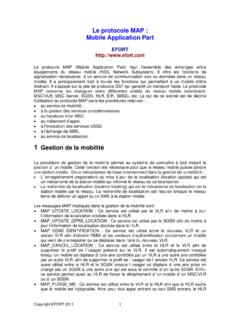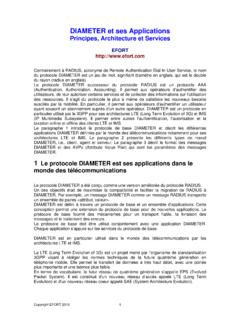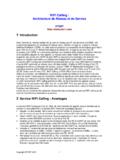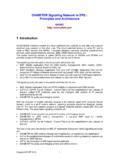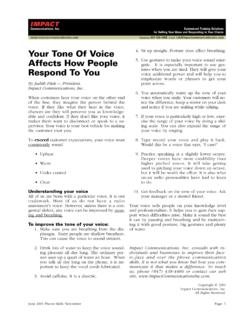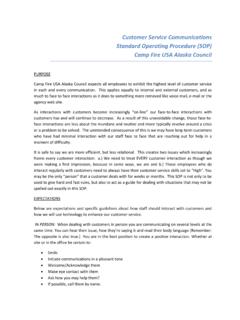Transcription of Voice over IP over LTE (VoLTE) Impacts on LTE access
1 Copyright EFORT 20141 Voice over IP over LTE ( volte ) Impacts on LTE (IP Multimedia Subsystems) has been around for some time, and many infrastructurevendors have invested heavily in developing IMS capabilities, solutions and products. Butmarket acceptance has been slower than expected. Now, with LTE (Long Term Evolution)taking shape, the IMS platform has been given a new role and a niche that will carry it aconsiderable distance into the future: volte ( Voice over LTE) as specified inRecommendation of GSMA. The goal ofVoLTE is to emulate the services of thecurrent circuit switched domain called R4,using the IMS architecture. These services includetelephony,videotelephony, all the telephony supplementary services, SMS, USSD servicesand CAMEL services. Another important service is SR-VCC (Single Radio Voice Callcontinuity) which provides the ability to transition a Voice call from theVoIP/IMS packetdomain to the legacy circuit switched domain duringhandover from LTE to 3G/2G.
2 The goalof this tutorialis to present IMS with EPS (Evolved Packet System) as the broadband accessnetwork. EPS consists of an IP-based access called LTE (Long Term Evolution of 3G) and apacket core network calledePC (Evolved Packet Core). EPS is a broadband access networkconnected to the IP world (Internet / Intranet).This tutorial emphasizes the Impacts of IMS over the EPS access ArchitectureLTE provides IP based access with a very highbitrate. Evolved packet core (EPC) is an allIPcore networkarchitecture through which LTE and other 3 GPP and non-3 GPP accessnetworks fulfills the requirements for security,QoS, Mobility andconnection to IP based services, , Packet System (EPS) is also used and just refers to the LTE accessnetwork andEPC LTE consists ofeNodeBs which represent high-capacity base stations for LTE radioaccess EPC consists of the following elements: The Mobility Management Entity (MME)performs the signaling and control functions tomanage the User Equipment (UE) access to network connections,the assignment ofnetwork resources, and the management of the mobility states to support tracking,paging, roaming andhandovers.
3 MME controls all control plane functions related tosubscriber andsession management. The Serving GW (SGW) is a data planeelement whose primary function is to manageuser-plane mobility and act as a demarcation point between the RANandcore maintains data paths betweeneNodeBs and the PDN Gateway(PGW). Like the SGW, the Packet Data Network Gateway (PDN GW) is the termination point ofthe packet datainterface towards the Packet Data Network(s) ( , IP networks). As ananchor point for sessions towards the external Packet Data Networks, the PDN GWsupports Policy and Charging Enforcement Function (PCEF)for the detection of servicedataflows, policy enforcement ( ofpackets) andflow-based components of importance for EPC are:Copyright EFORT 20142 The Home Subscriber Server (HSS) is the maindata storage for all subscriber andservice-related data.
4 It hosts 2G/3G, LTE and IMS subscriber data. The Equipment Identity Register (EIR) is the database used to check the status of anIMEI (International Mobile Equipment Identity), , if it has been reported stolen. Policy and Charging Rules Function (PCRF) is related the gating (blocking/authorizing IPflows) decisions, quality of service policies for the authorized flows as well as on thecharging policies applied. Subscription Profile Repository is the database which holds the subscriber authorizationsfor policy and charging control (PCC). These information are used by the PCRF to buildPCC rules which are then submitted to the PCEF. The Online Charging System (OCS) provides online (or real-time) credit control andquota management for subscriber data sessions.
5 The Offline Charging System (OFCS) receives charging data in the form of ChargingData Records (CDRs) and diameter accounting messages from network elements afterthe subscriber incurs network resource 1 :EPSA rchitectureIMS architecture is access independent and can provide IP-based services ( , IPtelephony) to any broadband user such as EPS shares theCx interface with the HSS (to obtain authentication vectors and IMS userprofile) andSh interface with the HSS (to obtain service data).The PCC (Policy and Charging Control) is convergent. It is used by EPS for policy andcharging control as well as by IMS for the same standard defines two charging interfaces,Gy andGz, which are used for online andoffline charging respectively. TheGy interface connects the PCEF to the Online ChargingSystem (OCS), which is used for flow based charging information transfer and control in anonline fashion.
6 TheGz interface is used between the PCEF within the PGW and the OfflineCharging System (OFCS), and it is applied when charging records are consolidated in anServing GWIP/GE NetworkUEeNode BIP NetworkPDN GWMMELTEePCHSSC ontrol planeUser planeS6S1-CS11S5 DIAMETER interfacePCEFIP/GE NetworkS1-US13 EIRGxOCSOFCSGyGzPCRFLTE : Long Term EvolutionePC: Evolved Packet CoreGW : GatewayMME : Mobility Management EntityPCRF : Policy and Charging Rules FunctionPDN : Packet Data NetworkHSS : Home Subscriber ServerEIR : Equipment Identity RegisterPCEF : Policy and Charging Enforcement FunctionOCS : Online Charging SystemOFCS : Offline Charging SystemSPR : Subscription Profile RepositorySPRC opyright EFORT 20143offline fashion. The Ro andRf interfaces are also used for charging in IMS respectively inonline and offline shares an Rx interface with the PCRF to request allocation of resources in the EPS( , reservation of conversationalQoS class for Voice or video telephony) to ensureQoS forany IMS multimedia session.
7 Rx commands are generally translated by the PCRF intoGxcommands towards the 2 : EPS and IMSLet s consider a user who wants to access to Internet services and IMS services. The userwill need to establish two default bearers each one with a given APN andQoS. As a resultthe user will be assigned two IP addresses, one for the Internet activity and one for IMSactivity (generally IPv6 address). The two default bearers may have differentQoS : forexample backgroundQoS for the default bearer related to Internet (QCI = 8 or 9) andInteractiveQoS for the default bearer related to IMS (QCI = 5).This approach allows separating the access to an IP world which supports IMS (Mobileoperator s intranet) from the public Internet network. In this case, access to each of thenetworks is done through a specific PDN GW, which allows implementing specific policy-enforcement rules or packet filtering algorithms depending on the type of packet networkbeing default bearer for Internet APN will transport all the internet traffic and will decrease thebitrate of these flows when the user will reach his fair use ( , 5 Gigabytes) within the billingcycle, while the default bearer for IMS APN will transport SIP signaling only between the UEand the two default bearers are handled by oneeNode B, one Serving GW and one or two PDNGWs.
8 Figure 3 shows the two default bearers when the user is in his home GWIP/GENetworkUEeNode BIP NetworkPDN GWMMELTEePCIMSHSSS6 GxRxCx, ShS11S5 OCSOFCSGyGzRoRfDIAMETER InterfacePCEFIMS : IP Multimedia SubsystemPCRFC ontrol planeUser planeIP/GE NetworkS1-CS1-US13 EIRSPRHSSUPSFC opyright EFORT 20144 Figure 3 : Connectivity for Internet access and IMS access when the user is in his homenetwork3 Default and Dedicated bearersThe IMS default bearer just transports the SIP traffic related for example to sessionestablishment/release, USSD service, SMS service, the user receives an incoming Voice call, a dedicated bearer is established for thetransport of real time Voice (RTP protocol). This dedicated bearer requires aQoS ofconversational class. A dedicated bearer shares the same APN, same IP address than thedefault bearer it is associated with, but has a differentQoS.
9 It is not possible to transport overthe same default bearer two IP flows which require differentQoS (SIP flow and RTP flow).When an incoming IP packet is received by PDN GW, it knows how to route it over theappropriate bearer thanks to the destination transport address (port number + IP address).The SIP and RTP flows are handled by different processes on the terminal and theseprocesses listen to different port numbers although they share the same IP avideotelephony call, two media components are generated and encoded differently : Voice component and video component. Since these components require differentQoS, twodedicated bearers are required, one per component. At the receiving side, the two flows aremixed before being the case of a Voice call put on hold and another ongoing Voice call, only one dedicatedbearer is required for the handling of the two Voice flows since they share the IMS, it is also important to handle the XCAP (XML Configuration access Protocol) is a protocol which enables a user configuring his service data ( , modifying a callforwarding number, changing his barring services) on the Multimedia Telephony ApplicationServer (MTAS).
10 The XCAP flow is typically carried over the default bearer of the concept of dedicated bearer may also apply to the Internet access . Parallel to the defaultbearer, a dedicated bearer may be established for the transport of theSkype traffic(ConversationalQoS) or for the delivery of multimedia networked game commands(InteractiveQoS) or for the reception of Video on demand flows (StreamingQoS), if thecustomer accepts to pay for thatQoS and if the service provider proposes such important APN is Emergency . If the user wants to attach just to establish anemergency call, his UE sends an attach request to the MME with attach type =PDNG atewayDefault bearer for Internet accessServingGatewayPDNG atewayIP NetworkP-CSCFD efault bearer forIMS accessInternetSGW : Serving GWPGW : PDN GWeNodeBPCEFPCEFC opyright EFORT 20145 Emergency.
